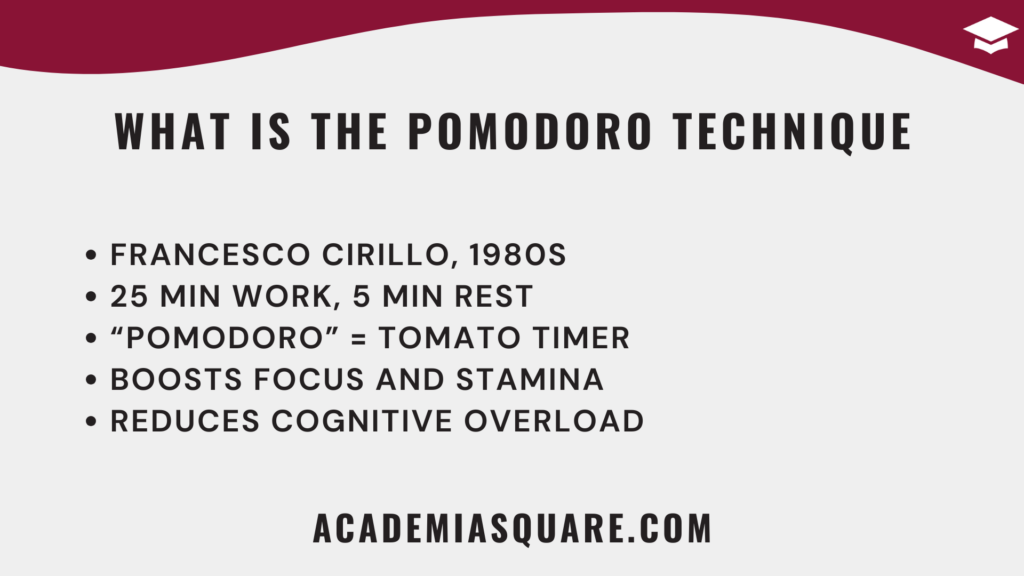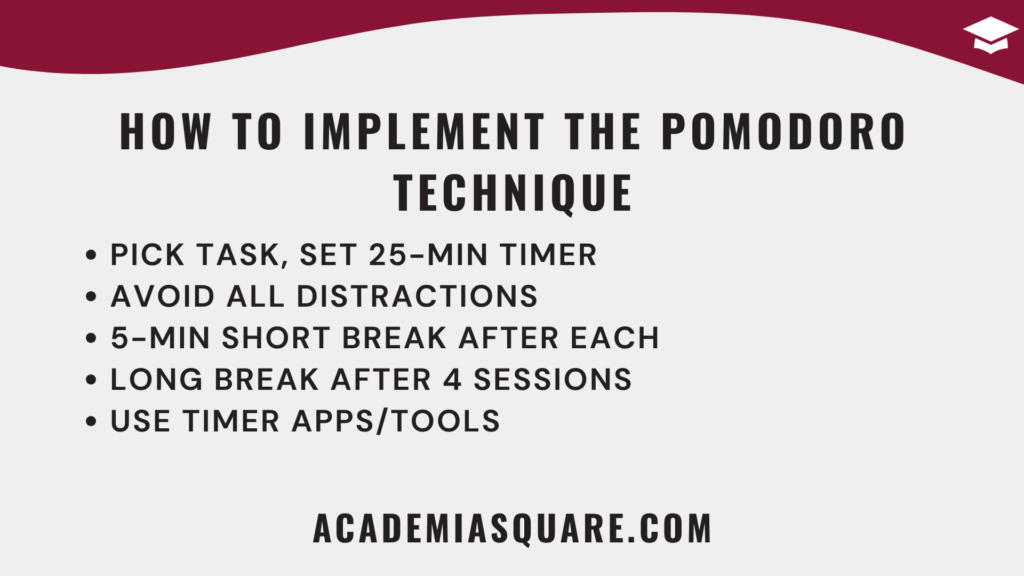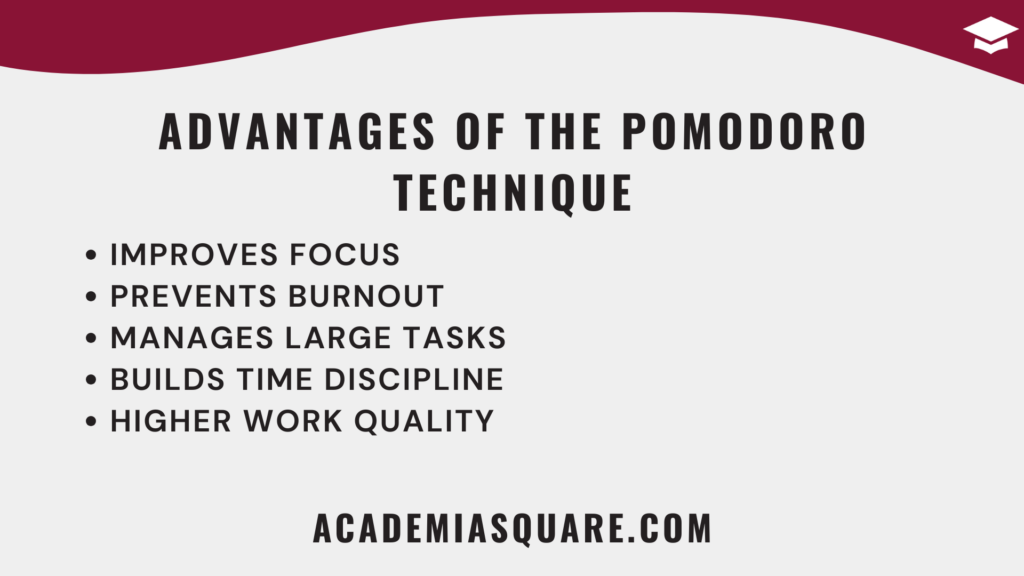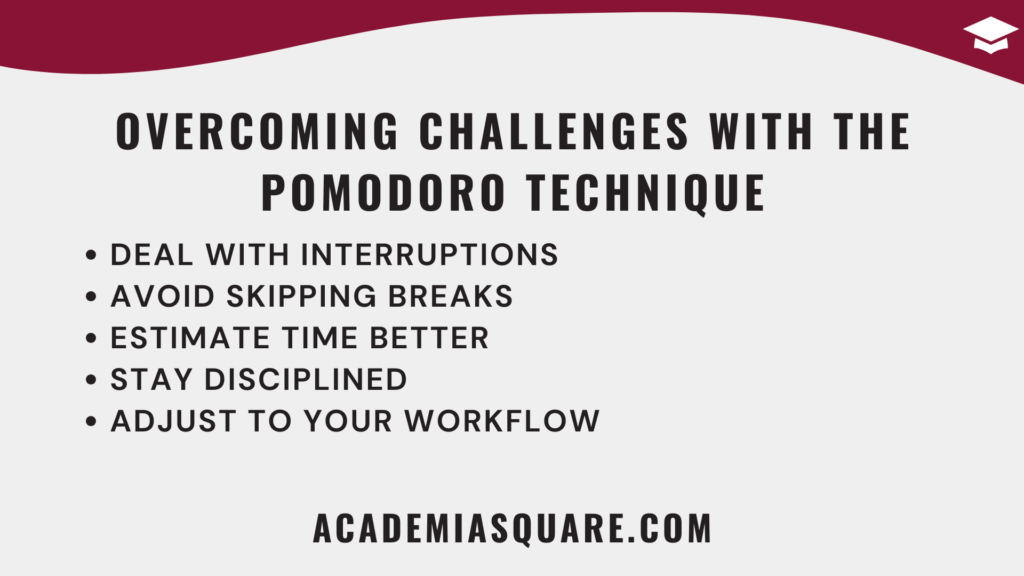The Pomodoro Technique is a powerful time management method that can significantly enhance productivity. In this chapter, I’ll introduce you to the Pomodoro Technique, explain its origins, and outline its fundamental principles. Whether you’re a student, a professional, or someone who simply wants to get more done with less stress, this method offers a practical structure for focused work sessions and deliberate rest.
What is the Pomodoro Technique

The Pomodoro Technique is a structured approach to time management that breaks your day into timed work intervals. These intervals, called “pomodoros” (Italian for “tomatoes”), typically consist of 25 minutes of focused work followed by a 5-minute break. After completing four pomodoros, you take a longer break of 15 to 30 minutes. This cycle is designed to help you work with – rather than against – your brain’s natural attention span.
This technique was invented by Francesco Cirillo in the late 1980s when he was a university student looking for a way to stay focused. Using a tomato-shaped kitchen timer, he began experimenting with short, timed intervals of study. The idea caught on because of its simplicity and effectiveness. Today, the 25/5 study method is used worldwide, in academic, corporate, and creative environments alike.
- 🕒 Breaks work into 25-minute focused sessions followed by short rests – proven to sustain concentration and reduce mental fatigue.
- 🧠 Increases productivity and focus by minimizing decision fatigue and task-switching (Cognition Journal, 2014).
- 📉 Helps combat procrastination by turning overwhelming tasks into manageable time blocks.
- ⚡ Supports deep work by creating a rhythm of effort and recovery that enhances overall efficiency.
- 📅 Widely adopted by students, professionals, and creators to build consistent study and work habits.
Why Timing Matters in the Pomodoro Technique
The reason the 25-minute work / 5-minute rest rhythm is so effective comes down to how the brain processes concentration and fatigue. Research from the University of Illinois suggests that people tend to experience a drop in attention called “vigilance decrement” after about 20 minutes of continuous focus. By inserting a short break before this decline occurs, the Pomodoro Technique helps preserve cognitive resources and prevent burnout.
In addition to protecting your mental stamina, this timing encourages a sense of urgency. You’re not just working – you’re racing the clock in a focused sprint. This limited window discourages procrastination and multitasking, and makes it easier to just start the task without overthinking it.
- 25 minutes of focused work = high engagement, no distractions
- 5 minutes of rest = mental reset, reduced cognitive fatigue
- 4 cycles followed by a longer break = sustainable deep work
The Psychological Power of a Simple Timer
At the heart of the Pomodoro Technique is a very simple tool: a timer. But its impact goes beyond just keeping track of minutes. The act of setting a timer creates a subtle psychological commitment. It signals to your brain that for the next 25 minutes, the only thing that matters is the task in front of you.
This works due to a psychological principle called implementation intention, where clearly defining “when” and “how long” a task will take increases the chances of following through. Instead of vaguely deciding to “work on a report,” you commit to “work on the report for 25 minutes,” which feels far more manageable and actionable.
Pomodoro as a Habit-Building System
Beyond short-term productivity, the Pomodoro Technique also helps you build consistent, repeatable work habits. Each 25-minute session acts like a small win. Over time, completing pomodoros becomes a habit loop—cue (timer starts), routine (you focus), reward (break and satisfaction of progress).
This is especially valuable for those trying to overcome procrastination. Instead of tackling an overwhelming project all at once, you’re breaking it into clear, time-boxed chunks. Behavioral researchers suggest that this reduces psychological resistance and builds momentum.
By starting small and staying consistent, the Pomodoro Technique can transform the way you approach tasks – not just in terms of productivity, but in how you mentally frame and execute your goals.
How to Implement the Pomodoro Technique

The Pomodoro Technique is remarkably easy to get started with, which is one of the reasons it has become so widely adopted across educational, professional, and creative settings. It doesn’t require expensive tools or complex systems – just a timer, a task, and the willingness to focus. But behind its simplicity lies a surprisingly powerful structure for tackling work with purpose and energy.
Step-by-Step Guide to the Pomodoro Method
At its core, the Pomodoro Technique is about building a rhythm of focused work and intentional rest. To begin using it, follow these basic steps:
- Step 1: Choose a single, specific task to focus on – ideally one that can be meaningfully advanced in 25 minutes.
- Step 2: Set a timer for 25 minutes. This is your first “pomodoro”.
- Step 3: Work with full concentration until the timer rings. If a distraction comes up, jot it down and return to your task immediately.
- Step 4: When the 25 minutes are up, take a 5-minute break. Stand up, stretch, hydrate, or breathe deeply.
- Step 5: After every 4 pomodoros, take a longer break of 15–30 minutes to fully reset before starting the next cycle.
This structure – often referred to as the 25/5 study method – can be adapted as needed, but its key strength is in encouraging consistent progress while preventing mental fatigue.
Creating the Right Environment for 25-Minute Focus Sessions
To truly benefit from the work 25 minutes rest 5 structure, it’s important to set up a work environment that supports deep focus. Start by identifying and minimizing common distractions. This might mean putting your phone on Do Not Disturb, closing unused browser tabs, or setting clear boundaries with people around you.
Consider using a simple pre-pomodoro checklist:
- Do I know exactly what I’m working on?
- Are all distractions turned off or minimized?
- Do I have everything I need to avoid interruptions during the 25 minutes?
These small steps can make a big difference in helping you enter a state of flow quickly and stay there until the timer rings.
Helpful Tools for Managing Your Pomodoros
While a basic kitchen timer or phone stopwatch is all you need, many people prefer using digital tools to track their pomodoros more efficiently. Here are a few popular options:
- Focus Booster: Offers session history and productivity charts.
- Pomodone: Integrates with apps like Trello and Todoist for task syncing.
- Tomato Timer: A minimalist web-based timer perfect for beginners.
Some tools also allow you to customize interval lengths, helping you experiment with variations like 50/10 or 90/20 if the classic 25/5 format doesn’t match your natural workflow. Apps like Be Focused and Forest even gamify the process to make staying focused more fun and rewarding.
Examples of the Pomodoro Technique in Action

The Pomodoro Technique can be applied to a variety of tasks and settings, making it a versatile tool for enhancing productivity. Here are some examples of how different individuals use the Pomodoro Technique in their daily lives.
For students, the Pomodoro Technique can be especially beneficial when preparing for exams. By breaking study sessions into focused 25-minute intervals, students can improve their concentration and retention of information. For more effective study techniques, consider exploring these effective study techniques and strategies for improving memory retention.
Professionals often use the Pomodoro Technique to manage their workloads and increase productivity. For example, a writer might dedicate multiple pomodoros to drafting a manuscript, taking short breaks in between to prevent burnout. Similarly, a software developer could use the technique to focus on coding sessions, ensuring steady progress on projects without feeling overwhelmed.
Creative individuals can also benefit from the Pomodoro Technique. Artists, musicians, and designers might use pomodoros to work on their craft, maintaining a balance between intense focus and necessary breaks. This method helps sustain creativity and prevent fatigue, making it easier to produce high-quality work consistently.
Additionally, the Pomodoro Technique can be applied to everyday tasks such as household chores or personal projects. By breaking these tasks into manageable intervals, you can maintain motivation and avoid feeling overwhelmed. This approach is particularly useful for tackling large projects that might otherwise seem daunting.
Advantages of the Pomodoro Technique

The Pomodoro Technique offers numerous advantages for those looking to boost their productivity and manage their time more effectively. One of the primary benefits is improved focus. By dedicating 25-minute intervals to a single task, you can minimize distractions and maintain a high level of concentration.
Another significant advantage is the reduction of burnout. The Pomodoro Technique encourages regular breaks, which are essential for maintaining mental clarity and reducing fatigue. This balance between work and rest helps sustain long-term productivity and prevents the exhaustion that often accompanies prolonged work sessions.
Additionally, the Pomodoro Technique promotes better time management. By breaking tasks into smaller, manageable intervals, you can make even the most daunting projects feel more achievable. This structured approach can also help you stay on track and meet deadlines more consistently.
Moreover, the Pomodoro Technique can enhance the quality of your work. When you focus intensely for short periods, you are more likely to produce higher quality output. This method encourages a more thoughtful and thorough approach to tasks, leading to better results overall.
Overcoming Challenges with the Pomodoro Technique

The Pomodoro Technique is highly effective, but it is not without its challenges. One common obstacle is dealing with interruptions. Unexpected disruptions can break your focus and reduce the effectiveness of your pomodoros. To overcome this, it is crucial to create a distraction-free environment and communicate your work boundaries to others.
Another challenge is maintaining discipline. Sticking to the Pomodoro Technique requires commitment and consistency. It can be tempting to skip breaks or extend work intervals, but doing so can lead to burnout. To stay disciplined, remind yourself of the benefits of regular breaks and the importance of adhering to the technique’s structure.
Some people may find it difficult to estimate how many pomodoros a task will take. This can lead to frustration if you underestimate the time needed. To address this, start by breaking tasks into smaller sub-tasks and track the time each one takes. Over time, you’ll develop a better sense of how long different tasks require, allowing for more accurate planning.
Lastly, it’s important to adapt the Pomodoro Technique to fit your personal needs. Not every task or individual will thrive on the traditional 25/5 minute split. Experiment with different intervals to find what works best for you. Customizing the technique can help you overcome any initial difficulties and maximize its benefits.
Customizing the Technique to Fit Your Needs

The Pomodoro Technique is highly adaptable, allowing you to tailor it to your specific needs and preferences. Customizing your pomodoro intervals is one way to make the technique work better for you. While the standard 25-minute work interval works well for many, you might find that shorter or longer periods are more effective for certain tasks.
Another way to customize the Pomodoro Technique is by adjusting your break times. If you find that a 5-minute break isn’t enough to recharge, try extending it to 10 minutes. Conversely, if you feel fully refreshed after just a couple of minutes, shorter breaks might be more suitable for maintaining your momentum.
Integrating other productivity methods can also enhance the effectiveness of the Pomodoro Technique. For example, combining it with time blocking can provide a more comprehensive approach to managing your schedule. By allocating specific blocks of time to different tasks, you can ensure that you remain focused and productive throughout the day.
Finally, consider using various tools and apps to support your use of the Pomodoro Technique. Apps like Focus Booster and Tomato Timer can help you track your intervals and breaks, while also providing insights into your productivity patterns. Experimenting with different tools can help you find the ones that best suit your workflow and enhance your overall productivity.
Tools and Apps for the Pomodoro Technique
There are several tools and apps available that can enhance your experience with the Pomodoro Technique and help you stay focused and productive. These tools provide timers, task lists, and other features designed to support effective time management.
One popular app is Focus Booster, which offers customizable pomodoro timers and productivity tracking. It allows you to set sessions, breaks, and track your progress over time. Another useful tool is Pomodone, which integrates with popular task management platforms like Trello and Todoist, making it easy to incorporate the Pomodoro Technique into your existing workflow.
For those who prefer a minimalist approach, Tomato Timer is a simple online timer that helps you stay on track without distractions. It’s straightforward to use and perfect for individuals who want a basic pomodoro timer without additional features.
Additionally, many time management and productivity apps offer pomodoro timers as part of their feature sets. Apps like Forest and Be Focused provide gamified experiences that encourage focus and discourage distractions. These apps can be particularly motivating for users who thrive on visual progress and rewards.
The Science Behind the 25-5 Technique
The Pomodoro Technique is supported by psychological and neurological principles that explain its effectiveness in improving productivity and focus. At its core, the technique leverages the concept of timeboxing, which breaks work into discrete intervals to enhance concentration and prevent mental fatigue.
Research has shown that regular breaks, such as those encouraged by the Pomodoro Technique, can improve mental agility and creativity. By alternating periods of focused work with short breaks, individuals can sustain high levels of performance over extended periods without experiencing burnout.
Neurologically, the Pomodoro Technique aligns with the brain’s natural rhythms of attention and rest. During focused work intervals, the brain activates specific neural networks associated with task engagement and goal-directed behavior. Short breaks allow these networks to rest and recover, ensuring that cognitive resources remain available for sustained productivity.
Psychologically, the Pomodoro Technique promotes a sense of accomplishment and progress. Each completed pomodoro represents a small milestone, providing a tangible sense of achievement and motivating individuals to continue their work. This cycle of work and reward reinforces productivity habits and encourages consistent effort over time.
Moreover, the Pomodoro Technique can be integrated with other evidence-based strategies to optimize performance. Techniques such as spaced repetition for learning and mindfulness practices for stress reduction complement the structured approach of the Pomodoro Technique, creating a holistic framework for personal and professional growth.
Pomodoro Technique vs. Other Time Management Methods
The Pomodoro Technique is one of the most popular and approachable time management strategies, but it’s not the only one. There are several other well-known systems used by students, professionals, and productivity enthusiasts – each with its strengths and ideal use cases. Understanding how the Pomodoro Technique compares with these alternatives can help you choose the best fit for your goals and working style.
Pomodoro vs. Time Blocking
Time blocking involves scheduling specific tasks on your calendar in advance. Instead of working from a to-do list, you divide your day into “blocks” of time where each block is reserved for a particular activity. This method is great for structured planning and ensuring that high-priority tasks get dedicated attention.
Compared to time blocking, the 25/5 study method offers more flexibility. While time blocking tells you *when* to work, Pomodoro focuses on *how* to work during that time – with focused bursts and scheduled breaks. Many people actually combine both approaches: block time in your calendar for deep work and use Pomodoro intervals during those blocks.
- Time Blocking: Great for long-term scheduling and prioritization
- Pomodoro Technique: Better for maintaining focus within those blocks
Pomodoro vs. Getting Things Done (GTD)
Getting Things Done, or GTD, is a productivity system developed by David Allen. It emphasizes collecting tasks into an external system, organizing them by context or priority, and regularly reviewing them to stay in control. GTD is ideal for people who manage a lot of projects and need a structured system to handle complexity.
The Pomodoro Technique, by contrast, is more execution-oriented. It doesn’t dictate how to organize your tasks – it just helps you get started and stay focused on one task at a time. In fact, many GTD users incorporate Pomodoro into their “Do” phase to increase execution efficiency once tasks have been identified.
- GTD: Best for managing large volumes of tasks and projects
- Pomodoro: Best for boosting focus and reducing procrastination
Pomodoro vs. The Eisenhower Matrix
The Eisenhower Matrix is a decision-making framework that categorizes tasks by urgency and importance. It’s excellent for prioritizing what matters most and avoiding time wasted on unimportant or non-urgent work. You divide tasks into four quadrants: Do Now, Schedule, Delegate, and Eliminate.
While the Eisenhower Matrix helps you decide what to work on, the Pomodoro Technique helps you actually do the work. These two methods complement each other well: use the matrix to sort your tasks, then use Pomodoro sessions to complete the high-priority ones with full focus.
- Eisenhower Matrix: Best for making strategic task choices
- Pomodoro: Best for executing those choices with structure
Which Time Management Strategy Is Right for You?
Each time management method serves a different purpose, and often the most effective approach is to combine elements of multiple systems. Here’s a quick guide:
- Use Pomodoro when you struggle with focus, procrastination, or mental fatigue.
- Use Time Blocking when you want to control your schedule and allocate priorities clearly.
- Use GTD when you’re juggling many tasks, projects, or responsibilities and need a reliable system.
- Use the Eisenhower Matrix when you need to clarify what’s truly important.
The work 25 minutes rest 5 method fits especially well into modern attention-limited workflows. Whether used on its own or as part of a larger system, it can make overwhelming workloads feel manageable and help you build momentum, one session at a time.
Tips for Maximizing Pomodoro Technique Effectiveness
While the Pomodoro Technique is straightforward to implement, there are several tips you can follow to maximize its effectiveness and achieve optimal results.
Firstly, create a conducive work environment free from distractions. Minimize interruptions by silencing notifications, closing unnecessary tabs, and setting clear boundaries with colleagues or family members.
Secondly, prioritize tasks before starting a pomodoro session. Identify the most critical tasks that align with your goals and tackle them during your peak productivity hours.
Thirdly, use the breaks wisely. Instead of checking social media or emails, engage in activities that promote relaxation and rejuvenation, such as stretching, deep breathing, or taking a short walk.
Lastly, track your progress and reflect on your productivity patterns. Use tools or apps to monitor your pomodoros and identify areas for improvement. Adjust your pomodoro durations or break times based on what works best for you.
Conclusion
The Pomodoro Technique is a proven method for enhancing productivity and managing time effectively. By breaking work into focused intervals and incorporating regular breaks, individuals can improve their concentration, productivity, and overall well-being. Whether you’re a student preparing for exams, a professional managing deadlines, or a creative individual pursuing personal projects, the Pomodoro Technique offers a versatile approach to achieving your goals.
Implementing the Pomodoro Technique requires discipline and consistency, but the rewards are substantial. By integrating this technique into your daily routine and customizing it to fit your needs, you can experience increased productivity, reduced stress, and a greater sense of accomplishment. Embrace the Pomodoro Technique as a powerful tool for optimizing your time and achieving success in both your personal and professional endeavors.
FAQs – The Pomodoro Technique and Productivity
What is the Pomodoro Technique?
The Pomodoro Technique is a time management method developed by Francesco Cirillo in the late 1980s. It involves working in focused intervals of 25 minutes followed by a 5-minute break. After four cycles, a longer break of 15–30 minutes is taken. This method boosts focus and reduces mental fatigue.
How does the Pomodoro Technique improve productivity?
The technique enhances productivity by preventing burnout, maintaining mental agility, and promoting sustained attention. A study published in the journal “Cognition” found that taking short breaks can improve focus over prolonged tasks (Ariga & Lleras, 2011).
Is the Pomodoro Technique effective for studying?
Yes, it’s highly effective for studying. The structured intervals help learners manage cognitive load and retain information better. According to research from the University of Illinois, brief diversions significantly improve task performance and memory retention.
How long is each Pomodoro session?
Each Pomodoro session typically consists of 25 minutes of focused work followed by a 5-minute break. After four sessions, a longer break of 15–30 minutes is recommended.
Can the Pomodoro Technique help with procrastination?
Absolutely. By breaking work into short, manageable intervals, the Pomodoro Technique reduces overwhelm and increases the likelihood of starting tasks – an essential step in overcoming procrastination, as supported by behavioral psychology research.
What tools can I use to implement the Pomodoro Technique?
You can use physical timers, smartphone apps like Focus Booster, Pomodone, or browser extensions such as Marinara Timer. These tools help automate the process and track your productivity.
Is the Pomodoro Technique suitable for all types of work?
It works well for most tasks requiring sustained focus, such as writing, coding, or studying. However, tasks requiring deep immersion or collaboration may need longer intervals or flexible adaptation.
How many Pomodoros should I aim for in a day?
It depends on your workload, but 8–12 Pomodoros (about 4–6 hours of focused work) is a sustainable goal for most people. Quality and consistency are more important than quantity.
Can the Pomodoro Technique reduce mental fatigue?
Yes. Research shows that regular breaks enhance cognitive recovery and reduce decision fatigue. The Pomodoro Technique’s built-in breaks prevent overstimulation and keep energy levels balanced throughout the day.
Is there scientific evidence supporting the Pomodoro Technique?
Yes. Studies in cognitive psychology, including research from Ariga & Lleras (2011) and the University of Illinois, support the idea that frequent breaks boost sustained attention and performance on long tasks.
Can I modify the Pomodoro intervals?
Absolutely. While the standard 25/5 structure is effective for many, some people adapt the intervals to suit their workflow, such as 50/10 or 90/20. The key is maintaining focused work followed by restorative breaks.
Sources and Recommended Reading on the Pomodoro Technique
- The case of adopting the Pomodoro time-management tool in a four-day working week. Time & Society, 2024.
- Effective Self-Management for Early Career Researchers in the Neurosciences. Neuron, 2020.
- Understanding Effort Regulation: Comparing ‘Pomodoro’ Breaks and Self-Regulated Breaks. British Journal of Educational Psychology, 2023.
- Enhanced Strategies for Time and Task Management. OpenStax College Success.
- Mastering Time: Strategies for Boosting Productivity and Managing Time Effectively. Archive.org.
- Can We Apply Pomodoro Technique in Academic Publishing? Annals of Medical and Health Sciences Research, 2023.
- An Exploratory Pedagogical Experience with Mindfulness and Time Management. Journal of the Scholarship of Teaching and Learning, 2023.
- 10 Effective Study Techniques Every Student Should Know. AcademiaSquare.
- Use of an Education and Coaching Intervention to Promote Occupational Balance in Graduate Occupational Therapy Students. Journal of Occupational Therapy Education, 2024.
- Toward a Holistic Approach to Reducing Academic Procrastination. Current Directions in Psychological Science, 2021.
- Anti-Procrastination Strategies, Techniques and Tools and Their Impact on Academic Performance. Journal of Education and Learning, 2024.


